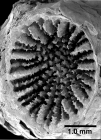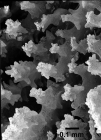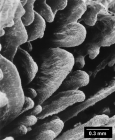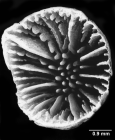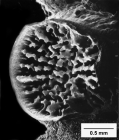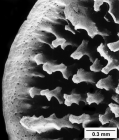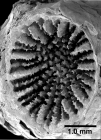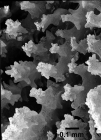
| Intro | | About | | Wiki | | Search traits | | Data explorer | | Literature | | Definitions | | Sources | | Webservices | | Statistics | | Feedback | | Editors | | Log in |
WoRMS taxon detailsCulicia Dana, 1846
205610 (urn:lsid:marinespecies.org:taxname:205610)
accepted
Genus
Culicia stellata Dana, 1846 (type by subsequent designation)
Angia Milne Edwards & Haime, 1848 · unaccepted > junior subjective synonym
Culitia Dana, 1846 · unaccepted > misspelling - incorrect subsequent spelling
Cylicia Milne Edwards & Haime, 1851 · unaccepted > junior subjective synonym
marine,
recent + fossil
Dana, J.D. (1846-1849). Zoophytes. United States Exploring Expedition during the years 1838-1842. <em>Lea and Blanchard, Philadelphia.</em> 7: 1-740, 61 pls. (1846: 1-120, 709-720; 1848: 121-708, 721-740; 1849: atlas pls. 1-61)., available online at https://www.biodiversitylibrary.org/page/18989497, http://www.sil.si.edu/digitalcollections/usexex/navigation/ScientificText/USExEx19_08select.cfm [details]
Depth range 0-378 m
Depth range 0-378 m [details] Description Genus of non-reef building scleractinians; Indo-Pacific. Colonial, budding occurs from rootlets but these are seen during...
Description Genus of non-reef building scleractinians; Indo-Pacific. Colonial, budding occurs from rootlets but these are seen during early stages only. Corallites are tubular with thin walls, thin, weakly toothed septa and weakly developed columellae. Polyps are extended day and night. They are small with short, straight radiating tentacles (Veron, 1986 <57>). [details] Fossil range Miocene to Recent
Fossil range Miocene to Recent [details]
Hoeksema, B. W.; Cairns, S. (2025). World List of Scleractinia. Culicia Dana, 1846. Accessed through: World Register of Marine Species at: https://www.marinespecies.org/aphia.php?p=taxdetails&id=205610 on 2025-07-15
Date action by 2006-07-31 06:57:06Z changed Camba Reu, Cibran
Nomenclatureoriginal description
Dana, J.D. (1846-1849). Zoophytes. United States Exploring Expedition during the years 1838-1842. <em>Lea and Blanchard, Philadelphia.</em> 7: 1-740, 61 pls. (1846: 1-120, 709-720; 1848: 121-708, 721-740; 1849: atlas pls. 1-61)., available online at https://www.biodiversitylibrary.org/page/18989497, http://www.sil.si.edu/digitalcollections/usexex/navigation/ScientificText/USExEx19_08select.cfm [details] original description (of Cylicia Milne Edwards & Haime, 1851) Milne Edwards, H.; Haime, J. (1851). Monographie des polypiers fossiles des terrains palaeozoïques, précédée d'un tableau général de la classification des polypes. <em>Muséum National d'Histoire Naturelle, Paris, Archives.</em> 5: 1–502, 20 pls., available online at https://www.biodiversitylibrary.org/page/25098869 [details] basis of record Veron JEN. (1986). Corals of Australia and the Indo-Pacific. <em>Angus & Robertson Publishers.</em> [details] Othercontext source (Hexacorallia)
Fautin, Daphne G. (2013). Hexacorallians of the World. (look up in IMIS) [details]
additional source Wells JW. (1936). The nomenclature and type species of some genera of recent and fossil corals. <em>American Journal of Science.</em> 31: 97-134., available online at https://ajsonline.org/article/61464 [details] additional source Scheer G, Pillai CSG. (1974). Report on Scleractinia from the Nicobar Islands. <em>Zoologica, Stuttgart.</em> 42(122): 1-75. page(s): 9, 55, 74 [details] additional source Cairns, S.D., R. Baron-Szabo, A.F. Budd, B. Lathuilière, E. Roniewicz, J. Stolarski & K.G. Johnson. (2010). Corallosphere. , available online at http://www.corallosphere.org [details] additional source Baron-Szabo, R.C. & S.D. Cairns. (2016). Systematic descriptions of the Scleractinia - Family Rhizangiidae (nr. 80). <em>Treatise Online, Part F, Revised.</em> Volume 2, Chapter 10: 1-10. [details] additional source Cairns, S. D. (1991). A Revision of the Ahermatypic Scleractinia of the Galapagos and Cocos Islands. Smithsonian Contributions to Zoology, 504; 44 pp. page(s): 7, Plate 1i, j [details] Available for editors additional source Neave, Sheffield Airey. (1939-1996). Nomenclator Zoologicus vol. 1-10 Online. <em>[Online Nomenclator Zoologicus at Checklistbank. Ubio link has gone].</em> , available online at https://www.checklistbank.org/dataset/126539/about [details]  Present Present  Inaccurate Inaccurate  Introduced: alien Introduced: alien  Containing type locality Containing type locality
Nontype HLD X2: 127-47, geounit Indian Exclusive Economic Zone [details]
From editor or global species database
Biology azooxanthellate [details]Classification Placed in the family Astrangiidae in Faure, G. (1977). [details] Depth range 0-378 m [details] Description Genus of non-reef building scleractinians; Indo-Pacific. Colonial, budding occurs from rootlets but these are seen during early stages only. Corallites are tubular with thin walls, thin, weakly toothed septa and weakly developed columellae. Polyps are extended day and night. They are small with short, straight radiating tentacles (Veron, 1986 <57>). [details] Diagnosis Corallum reptoid, additional corallites budded from a basal coenosteum, sometimes stoloniferous; corallites strongly epithecate, the epitheca riseing above the upper outer edges of the septa as a continuous rim; axial edges of S1 lobate, inner edges of remaining cycles dentate to laciniate; paliform lobes often present; columella papillose. [details] Fossil range Miocene to Recent [details] Remark About 15 species, most of them Recent (Cairns, 1995; Cairns et al., 1999; Chevalier, 1961). [details] Type designation Subsequent designation by Wells (1936) [details] |
